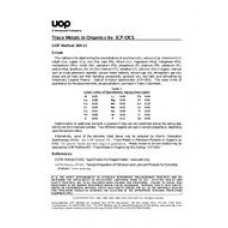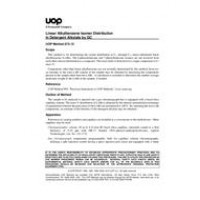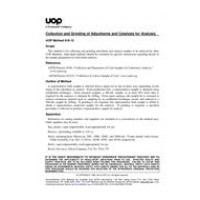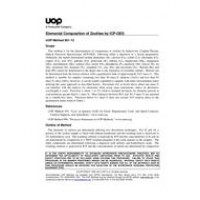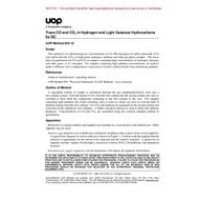UOP 389-15
- Trace Metals in Organics by ICP-OES
- standard by UOP LLC, A Honeywell Company, 02/25/2015
- Category: UOP
$240.00
$120.00
This method is for determining the concentrations of aluminum (Al), calcium (Ca), chromium (Cr), cobalt (Co), copper (Cu), iron (Fe), lead (Pb), lithium (Li), magnesium (Mg), manganese (Mn), molybdenum (Mo), nickel (Ni), palladium (Pd), phosphorus (P), platinum (Pt), potassium (K), sodium (Na), strontium, (Sr), tin (Sn), titanium (Ti), vanadium (V), and zinc (Zn) in organic matrices such as crude petroleum, asphalts, vacuum tower bottoms, vacuum gas oils, atmospheric gas oils, diesel and jet fuels and their blending components, pyrolysis oils, and fatty acid derivatives by Inductively Coupled Plasma – Optical Emission Spectrometry (ICP-OES). The lower limits of quantitation for the above elements, except palladium, are listed in Table 1 (see Note).
Determination of additional elements is possible if they are not volatilized during the ashing step and do not form insoluble sulfates. Two different reagents are used in sample preparation, depending upon the sample matrix.
Alternatively, some of the elements listed above may be analyzed by Atomic Absorption Spectroscopy (AAS). See UOP Method 391, “Trace Metals in Petroleum Products or Organics by AAS,” for specific metals and their range of quantitation. Metals known to be non-volatile may be analyzed by UOP Method 407, “Trace Metals in Organics by Dry Ashing - ICP-OES.”
 PDF
PDF
All of our standards document are available in PDF (Portable Document Format), an electronic, downloadable format.You will be able to download the file in your account downloads.
 Multi-User Access
Multi-User Access
After purchasing, you have the ability to assign each license to a specific user.
 Printable
Printable
At any time, you are permitted to make printed copies for your and your members' reference use.

